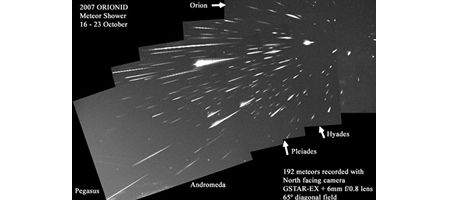We’ve got Jupiter to thank for the spectacular meteor showers associated with Halley’s comet, says an Armagh Observatory astronomer.

Halley’s comet orbits the sun in about 75 years. As its nucleus approaches the sun, it heats up and releases gas and dust that form the spectacular tail – and which leave a trail of debris along the orbit.
When the Earth crosses Halley’s path, twice per orbit, these dust particles burn up in the atmosphere, creating meteor showers: the Orionids in October and the Eta Aquariids in May.
Aswin Sekhar says that the drama is heightened by the fact that the comet has in the past been ‘in resonance’ with Jupiter – a numerical relationship that influences orbital behaviour.
This, he says, would increase the chances of resonant meteoroids appearing in the stream, with the particles ejected during those periods experiencing a tendency to clump together because of periodic effects from Jupiter.
“This resonant behaviour of meteoroids means that Halley’s debris is not uniformly distributed along its orbital path,” he says.
“When the Earth encounters one of these clumps, it experiences a much more spectacular meteor shower than usual.”
To reach his conclusions, Sekhar modelled Halley’s orbital evolution over more than 12,000 years into the past and 15,000 years into the future. The model suggests that from 1404 BC to 690 BC, Halley was trapped in a 1:6 resonance with Jupiter, in which Halley completed one orbit for every six orbits of Jupiter around the sun. Later, from 240 BC to 1700 AD, the comet’s orbit had a 2:13 relationship with Jupiter’s orbit.
Debris deposited during these two periods can be directly attributed to heightened activity in the Orionid meteor showers in some years, he says.
The theory could explain the unusual Orionid outburst observed in 1993, as being due to 2:13 resonant meteoroids ejected from Halley around 240 BC. If so, Sekhar predicts, we’ll see a similarly dramatic display of meteors in 2070.






